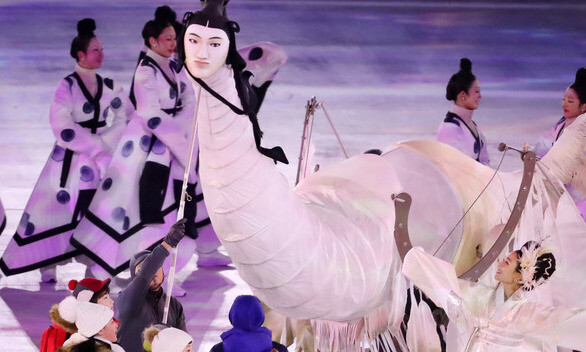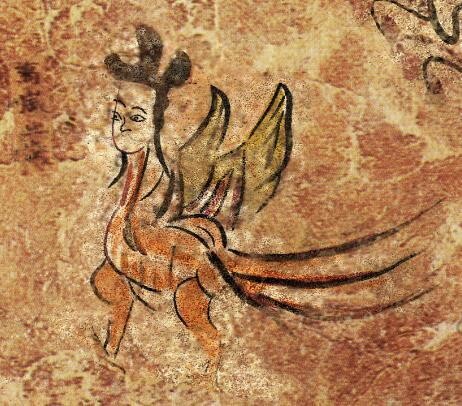hankyoreh
Links to other country sites 다른 나라 사이트 링크
[Reporter’s Notebook] Korea’s cultural heritage comes to life at Pyeongchang Olympics

It was a remarkable innovation that no one expected – Korea’s ancient cultural heritage was dramatically brought back to life at the Olympics. During the opening ceremony of the Pyeongchang Winter Olympics on Feb. 9 and the closing ceremony on Feb. 25, Korean cultural properties more than 1,500 years old leaped onto the stage and became stars. The highlight was the inmyeonjo, a mythical creature with the body of a bird of superhuman height, a giraffe-like neck, and an attractive male face under a traditional Korean hat.
Inspired by a mural from a Goguryeo tomb, this peculiar creature – half human and half beast – sashayed around the stage as it flapped its wings. People around the world were captivated by its every move, and it gained a following on social media. During the opening ceremony, the dance depicted in a mural in the Goguryeo Tomb of the Dancers (Muyongchong, located in Jilin Province in Manchuria) became a reality, with the inmyeonjo in the background.
Goguryeo was a Korean kingdom that was located in the northern and central areas of the Korean Peninsula, and also encompassed portions of Manchuria. It was one of the three earliest Korean kingdoms, along with Baekje and Silla, and existed from 37 BC - 668.

The attire of the dancers in the mural – long polka-dotted blouses with strings tied around the waist – were redesigned as minimalistic white dresses with inky spots seemingly made by a brush. The animal that led the children into the festival area after the bell of peace rang to mark the beginning of the Olympics was the white tiger that appears on the Goguryeo mural at the Kangso Large Tomb located in South Pyongan Province in North Korea. Atop the Baekdudaegan mountain range, represented through cutting-edge digital imagery, mythical creatures and figures from Goguryeo murals frolicked with tutelary deities from country shrines. The masses were excited to gain a new-found appreciation for ancient heritage.
The Pyeongchang Olympics’ success represented a fusion of the latest technological prowess with Korea’s ancient heritage. Both the opening and closing ceremonies were grounded in the concept of rediscovering the culture of Goguryeo. During the initial planning stage, Song Seung-hwan, director-general of the Pyeongchang closing ceremony, communicated extensively with academic experts on cultural properties, including Jeon Ho-tae, a professor at the University of Ulsan and the greatest authority on Goguryeo murals.

Goguryeo was the country that forged the basic cultural framework on the Korean Peninsula, and it was there that the name “Goryeo” (the origin of the word “Korea”) was first used, during the reign of King Jangsu in the 5th century. The openness and creativity that were characteristic of Goguryeo culture were fully utilized during the opening and closing ceremonies, which can be regarded as the impetus for those ceremonies’ success.
The inmyeonjo had already appeared in the “Classic of Mountains and Seas,” an ancient Chinese book of geography, and in East Asia it was regarded as a messenger of long life, peace, and the unity of nature and mankind in the development of Taoism and Buddhism. This mythical creature was creatively depicted in several murals by the people of Goguryeo. The inclusion of inmyeonjo, as a sacred creature shared by the people of East Asia, with its face fashioned after the “gaksital” mask of the Joseon Dynasty, can be seen as an inspired culture-historical blend.
“Since everything was integrated into the unique cultural brand of Goguryeo, which was a multicultural country with a good mixture of universality and distinctiveness, that identity appears to have been compelling given Korea’s current transition into a multicultural state in the 21st century global era,” Jeon Ho-tae said.
There is a clear evolution beyond an informational approach to Korea’s ancient cultural heritage toward drawing themes and inspiration for design and artistic work using images from that heritage and from the related sentiment. While academics have already been paying attention to the media potential of ancient heritage, the public’s growing interest is a change brought about by the Pyeonchang Olympics.
Not only Goguryeo murals but also items from the tombs of Baekje and Shilla, the patterns found on handicrafts and roof tiles and the images of plants, animals, and natural spirits are an inexhaustible treasure trove of the imagination. Now is the time to move forward with industrial-educational cooperation in the field of cultural heritage, with the media industry and cultural heritage scholars joining hands to cross boundaries.
By Roh Hyung-suk, Culture correspondent
Please direct questions or comments to [english@hani.co.kr]

Editorial・opinion
![[Column] Park Geun-hye déjà vu in Yoon Suk-yeol [Column] Park Geun-hye déjà vu in Yoon Suk-yeol](https://flexible.img.hani.co.kr/flexible/normal/500/300/imgdb/original/2024/0424/651713945113788.jpg) [Column] Park Geun-hye déjà vu in Yoon Suk-yeol
[Column] Park Geun-hye déjà vu in Yoon Suk-yeol![[Editorial] New weight of N. Korea’s nuclear threats makes dialogue all the more urgent [Editorial] New weight of N. Korea’s nuclear threats makes dialogue all the more urgent](https://flexible.img.hani.co.kr/flexible/normal/500/300/imgdb/original/2024/0424/7317139454662664.jpg) [Editorial] New weight of N. Korea’s nuclear threats makes dialogue all the more urgent
[Editorial] New weight of N. Korea’s nuclear threats makes dialogue all the more urgent- [Guest essay] The real reason Korea’s new right wants to dub Rhee a founding father
- [Column] ‘Choson’: Is it time we start referring to N. Korea in its own terms?
- [Editorial] Japan’s rewriting of history with Korea has gone too far
- [Column] The president’s questionable capacity for dialogue
- [Column] Are chaebol firms just pizza pies for families to divvy up as they please?
- [Column] Has Korea, too, crossed the Rubicon on China?
- [Correspondent’s column] In Japan’s alliance with US, echoes of its past alliances with UK
- [Editorial] Does Yoon think the Korean public is wrong?
Most viewed articles
- 1‘We must say no’: Seoul defense chief on Korean, USFK involvement in hypothetical Taiwan crisis
- 2N. Korean delegation’s trip to Iran shows how Pyongyang is leveraging ties with Moscow
- 3‘Weddingflation’ breaks the bank for Korean couples-to-be
- 4Will NewJeans end up collateral damage in internal feud at K-pop juggernaut Hybe?
- 546% of cases of violence against women in Korea perpetrated by intimate partner, study finds
- 6[Column] Park Geun-hye déjà vu in Yoon Suk-yeol
- 7“Parental care contracts” increasingly common in South Korea
- 8[Column] Yoon’s first 100 days should open our eyes to pitfalls of presidential system
- 9[Interview] Dear Korean men, It’s OK to admit you’re not always strong
- 10[Editorial] New weight of N. Korea’s nuclear threats makes dialogue all the more urgent